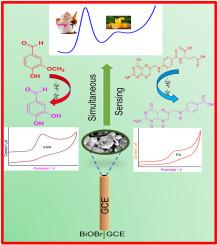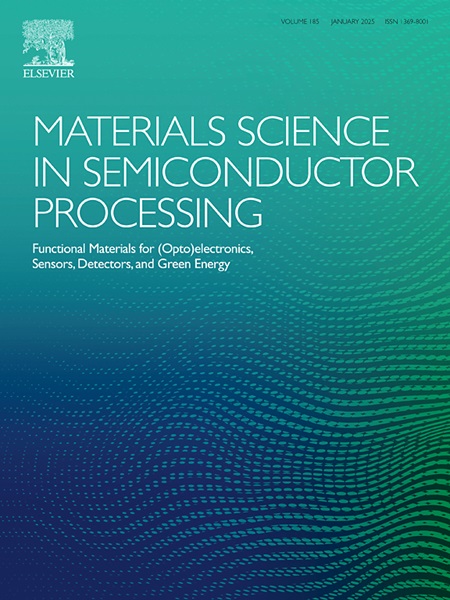Room temperature analysis of vanillin and folic acid in food samples using a BiOBr/GCE sensor: An empathetic and efficient approach
IF 4.2
3区 工程技术
Q2 ENGINEERING, ELECTRICAL & ELECTRONIC
引用次数: 0
Abstract
This study presents the development of an innovative sensor for detecting vanillin (VAN) in food samples containing folic acid (FA), an essential nutritional additive. Although these compounds offer significant health benefits, excessive consumption can lead to adverse effects, including VAN-induced allergic reactions and an increased risk of colorectal cancer associated with high levels of FA. This sensor addresses the critical need for precise quantification of VAN and FA in food samples, ensuring food safety and optimal nutritional balance. Biogenically synthesized BiOBr (BOB) nanostructures were efficiently immobilized on a glassy carbon electrode (GCE), exhibiting well-defined physical characteristics. The BOB/GCE sensor leverages the unique properties of both components to enhance its sensing capabilities. The BOB material increases the sensor's surface area, allowing for better adsorption of target molecules. Meanwhile, the BOB/GCE provides excellent electrical conductivity, facilitating efficient electron transfer. The sensor detects VAN and FA through electrochemical reactions, which occur when the target molecules interact with the BOB/GCE surface. This nanostructured platform was optimized for the rapid electrochemical detection of VAN and FA, offering a broad linear response range and a notably low detection limit (LOD). Linear calibration curves were obtained for VAN (4.3–113 μM) and FA (5.6–96.5 μM), with impressive detection limits of (0.057 μM and 0.068 μM) respectively. Anti-interference tests and real-sample analyses confirmed the material's potential for developing advanced electrochemical sensors. The BOB/GCE is ideally suited for real-time sensing in food applications, with recovery values validated against HPLC standards to ensure precision and accuracy.

使用 BiOBr/GCE 传感器对食品样品中的香兰素和叶酸进行室温分析:感同身受的高效方法
本研究介绍了一种创新型传感器的开发情况,该传感器用于检测含有叶酸(FA)的食品样品中的香兰素(VAN),叶酸是一种重要的营养添加剂。虽然这些化合物对健康大有益处,但过量食用会导致不良影响,包括由 VAN 引起的过敏反应以及与高水平 FA 相关的结肠直肠癌风险增加。该传感器满足了精确定量食品样品中 VAN 和 FA 的关键需求,确保了食品安全和最佳营养平衡。生物合成的 BiOBr(BOB)纳米结构被有效固定在玻璃碳电极(GCE)上,表现出明确的物理特性。BOB/GCE 传感器利用这两种成分的独特特性增强了传感能力。BOB 材料增加了传感器的表面积,从而可以更好地吸附目标分子。同时,BOB/GCE 具有出色的导电性,有利于有效的电子转移。当目标分子与 BOB/GCE 表面发生相互作用时,传感器通过电化学反应检测 VAN 和 FA。该纳米结构平台经过优化,可用于 VAN 和 FA 的快速电化学检测,具有宽广的线性响应范围和明显较低的检测限 (LOD)。VAN (4.3-113 μM)和 FA (5.6-96.5 μM)的线性校准曲线,检测限分别为 0.057 μM 和 0.068 μM。抗干扰测试和实际样品分析证实了这种材料在开发先进电化学传感器方面的潜力。BOB/GCE 非常适合食品应用中的实时传感,其回收值已根据 HPLC 标准进行了验证,以确保精度和准确性。
本文章由计算机程序翻译,如有差异,请以英文原文为准。
求助全文
约1分钟内获得全文
求助全文
来源期刊

Materials Science in Semiconductor Processing
工程技术-材料科学:综合
CiteScore
8.00
自引率
4.90%
发文量
780
审稿时长
42 days
期刊介绍:
Materials Science in Semiconductor Processing provides a unique forum for the discussion of novel processing, applications and theoretical studies of functional materials and devices for (opto)electronics, sensors, detectors, biotechnology and green energy.
Each issue will aim to provide a snapshot of current insights, new achievements, breakthroughs and future trends in such diverse fields as microelectronics, energy conversion and storage, communications, biotechnology, (photo)catalysis, nano- and thin-film technology, hybrid and composite materials, chemical processing, vapor-phase deposition, device fabrication, and modelling, which are the backbone of advanced semiconductor processing and applications.
Coverage will include: advanced lithography for submicron devices; etching and related topics; ion implantation; damage evolution and related issues; plasma and thermal CVD; rapid thermal processing; advanced metallization and interconnect schemes; thin dielectric layers, oxidation; sol-gel processing; chemical bath and (electro)chemical deposition; compound semiconductor processing; new non-oxide materials and their applications; (macro)molecular and hybrid materials; molecular dynamics, ab-initio methods, Monte Carlo, etc.; new materials and processes for discrete and integrated circuits; magnetic materials and spintronics; heterostructures and quantum devices; engineering of the electrical and optical properties of semiconductors; crystal growth mechanisms; reliability, defect density, intrinsic impurities and defects.
 求助内容:
求助内容: 应助结果提醒方式:
应助结果提醒方式:


